The industrial areas in Bangladesh are situated in the midst of densely populated regions and the growth of industries has generally been unplanned without keeping the issue of environmental protection in careful consideration. Gazipur District is one such industrial cluster where rapid, unplanned industrial expansion has led to serious local pollution. This area was historically important rice growing area but its close proximity to Dhaka has gradually led to more industries locating there over the past 15 years. There are now several types of industry in the area including a tannery, poultry farms and pharmaceutical industries but it is dominated by textile manufacturers, including dyeing and printing units. There are so many industries in Gazipur, only a few of them have installed Effluent Treatment Plant (ETP). Indiscriminate discharge of liquid waste by the industries has ruined a large part of the Turag River and Baimail Jheel, causing immense suffering to residents living on the banks, destroying fish and other aquatic lives. Fertile agricultural land is becoming infertile. Industrial liquid waste and black smog created by brick kilns have doubled the sufferings and even many villagers compelled to move their houses.
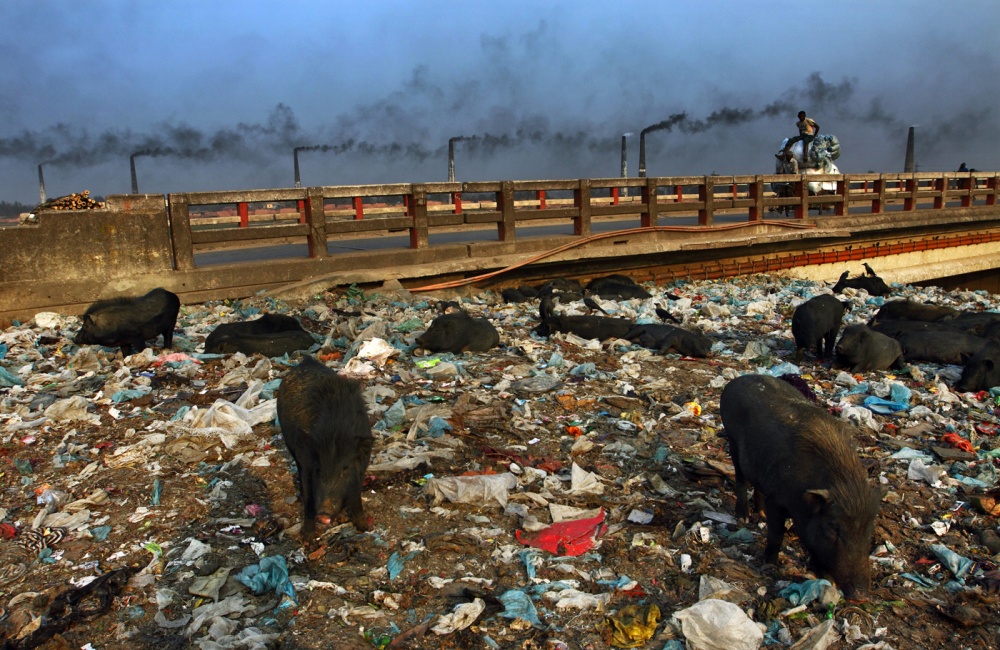
1 of 25
© 2024 Probal Rashid
The growth of industries in Bangladesh has generally been unplanned without keeping the issue of environmental protection. Dumping of various industrial wastes, often result in polluting the water, soil and air. Industrial liquid waste and black smog created by brick kilns have doubled the sufferings and even many villagers compelled to move their houses. The emission of various greenhouse gases such as CO2, CH4, among others from various industries, increases the overall temperature of the earth, resulting in global warming and making the area unsuitable for human habitation, animals and plant species.
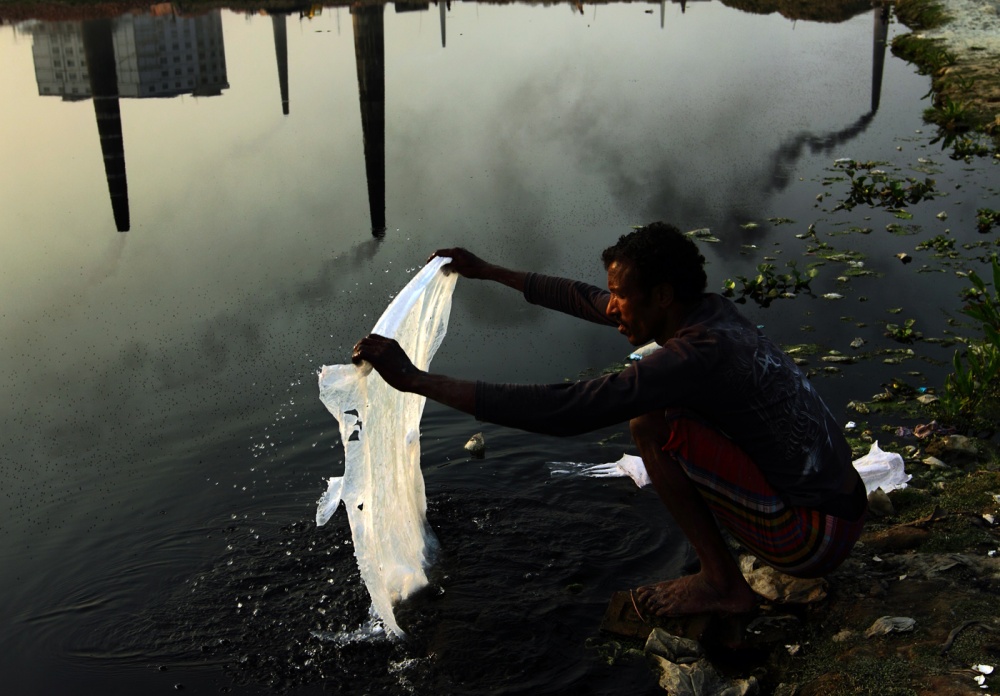
2 of 25
© 2024 Probal Rashid
A worker washes chemical factory’s wastes in the river water for recycling it. The factories are discharging untreated chemicals into water bodies which are destroying fish and other aquatic lives.
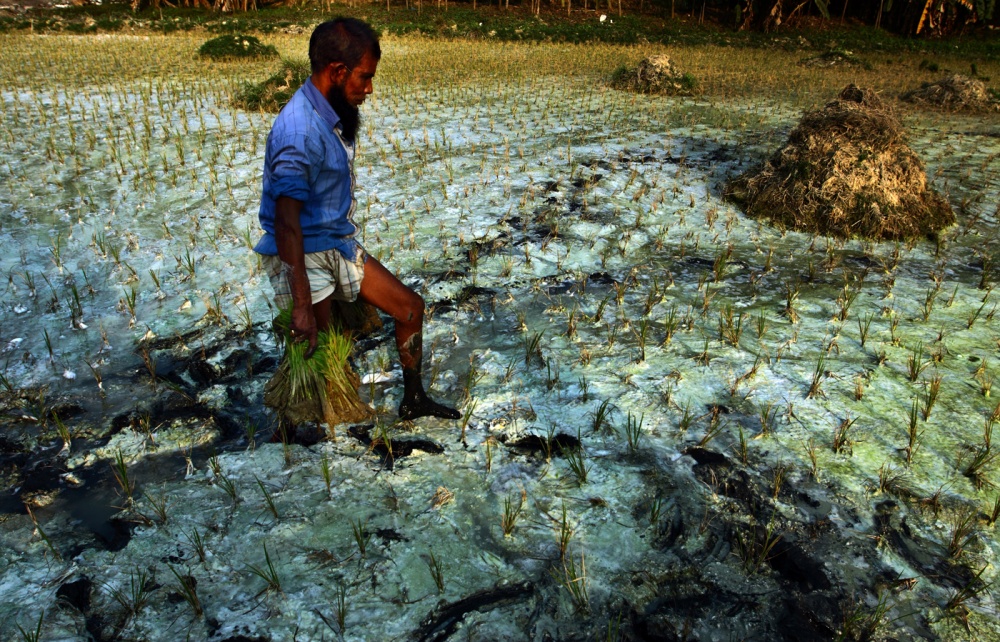
3 of 25
© 2024 Probal Rashid
A farmer replacing paddy plants which are totally damaged due to use of polluted river water. Dumping of various industrial waste products into water sources, and improper contamination of industrial wastes, often result in polluting the water. Such pollution disturbs the balance of the ecosystem inside, resulting in the death of various animal and plant species.

4 of 25
© 2024 Probal Rashid
Every day large amount of the industrial wastewater flow to the Turag River from Gazipur Industrial District. The wastewater sometimes is black, gray, silver or yellow, from different chemical factories has different colors.

5 of 25
© 2024 Probal Rashid
“We cannot use the water of Mokesh Beel in any way. Even we cannot take a bath there. At least 20 of our neighbors have left the village and settled in Gazipur town or nearby areas due to this environmental pollution. The industry waste has spoiled everything. We cannot afford moving from our village, so we are living here and suffering,†says Shukh Lal, profession of a boatman. Bangladesh has about 230 small and large rivers, and a large chunk of the country's 140 million people depend on them for a living and for transportation. But many of them are drying up or are choked because of pollution.

6 of 25
© 2024 Probal Rashid
Resident of riverbank is using the polluted water of Turag River. Indiscriminate discharge of liquid waste by the industries in and around Gazipur industrial zone has ruined a large part of the Turag River and Baimail Jheel, causing immense suffering to residents living on the banks. Moreover, the existence of heavy toxic metals such as chromium in the surrounding areas of Turag River may cause cancerous diseases.

7 of 25
© 2024 Probal Rashid
A boy jumps over a puddle of chemical and leather waste. The industrial areas in Bangladesh are situated in the midst of densely populated regions and the growth of industries has generally been unplanned without keeping the issue of environmental protection in careful consideration. Gazipur District is one such industrial cluster where rapid, unplanned industrial expansion has led to serious local pollution. Indiscriminate discharge of liquid waste by the industries has ruined a large part of the Turag River and Baimail Jheel, causing immense suffering to residents living on the banks, destroying fish and other aquatic lives.

8 of 25
© 2024 Probal Rashid
A worker washes chemical factory’s wastes in the River water for recycling it. The factories are discharging untreated chemicals into water bodies which are destroying fish and other aquatic lives.Every day large amount of the industrial wastewater flow to the Turag River from Gazipur Industrial District.

9 of 25
© 2024 Probal Rashid
Young boy swimming in the polluted water of Turag River. Indiscriminate discharge of liquid waste by the industries in and around Gazipur industrial zone has ruined a large part of the Turag River and Baimail Jheel, causing immense suffering to residents living on the banks. Moreover, the existence of heavy toxic metals such as chromium in the surrounding areas of Turag River may cause cancerous diseases.

10 of 25
© 2024 Probal Rashid
Brick field workers live on the bank of polluted River Turag. As the workers spend good part of the day working in the polluted environment, they often remain sick.

11 of 25
© 2024 Probal Rashid
Bangladesh has about 230 small and large rivers, and a large chunk of the country's 140 million people depend on them for a living and for transportation. But many of them are drying up or are choked because of pollution.

12 of 25
© 2024 Probal Rashid
Indiscriminate discharge of liquid waste by the industries in and around Gazipur industrial zone has ruined a large part of the Turag River and Baimail Jheel, causing immense suffering to residents living on the banks.

13 of 25
© 2024 Probal Rashid
The industrial areas in Bangladesh are situated in the midst of densely populated regions and the growth of industries has generally been unplanned without keeping the issue of environmental protection in careful consideration. Gazipur District is one such industrial cluster where rapid, unplanned industrial expansion has led to serious local pollution. Indiscriminate discharge of liquid waste by the industries has ruined a large part of the Turag River, causing immense suffering to residents living on the banks, fertile agricultural land is becoming infertile, disturbs the balance of the ecosystem inside, resulting in the death of various animal and plant species.

14 of 25
© 2024 Probal Rashid
Murad (age 15), a worker of black iron oxide manual factory. The environment in and around the factory is loaded with black iron, carbon dust, and other toxic materials. Every day he works for 10 – 12 hours in the polluted environment. Like him other hundreds of workers spend good part of the day working in polluted factory, inhaling harmful gasses and particles. Gazipur, Bangladesh

15 of 25
© 2024 Probal Rashid
Polluted river water disturbs the balance of ecosystem inside, resulting in the death of various animals and plant species present in the water.The growth of industries in Bangladesh has generally been unplanned without keeping the issue of environmental protection in careful consideration. Pollution emitted from the industries is also one of the major factors contributing towards water pollution. Dumping of various industrial waste products into water sources, and improper contamination of industrial wastes, often result in polluting the water.
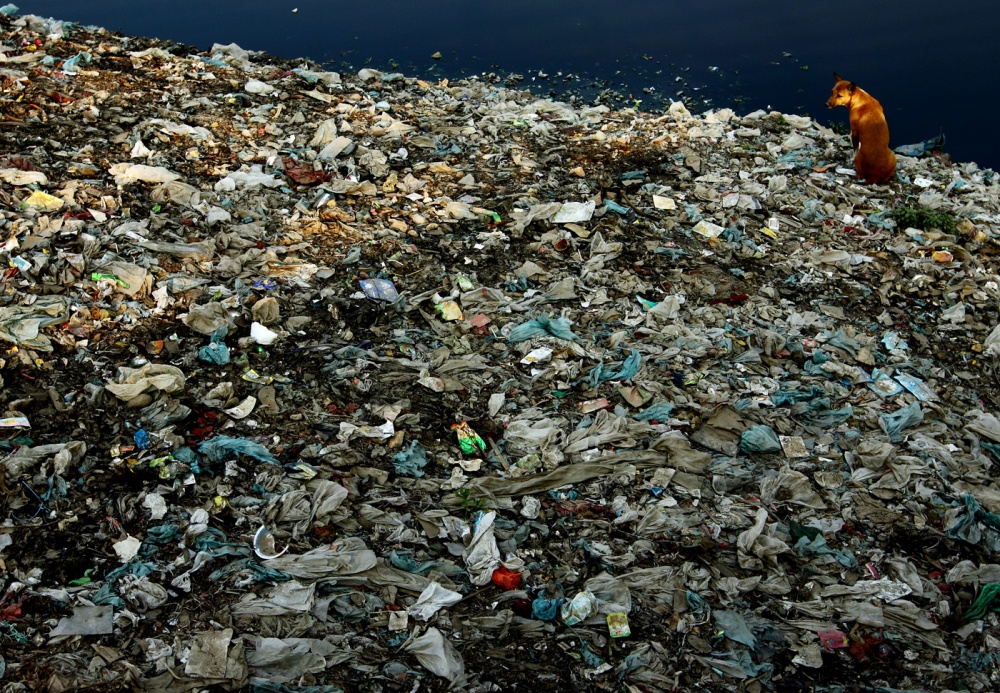
16 of 25
© 2024 Probal Rashid
The growth of industries in Bangladesh has generally been unplanned without keeping the issue of environmental protection. Dumping of various industrial wastes, often result in polluting the water, soil and air and making the area unsuitable for human habitation, animals and plant species.
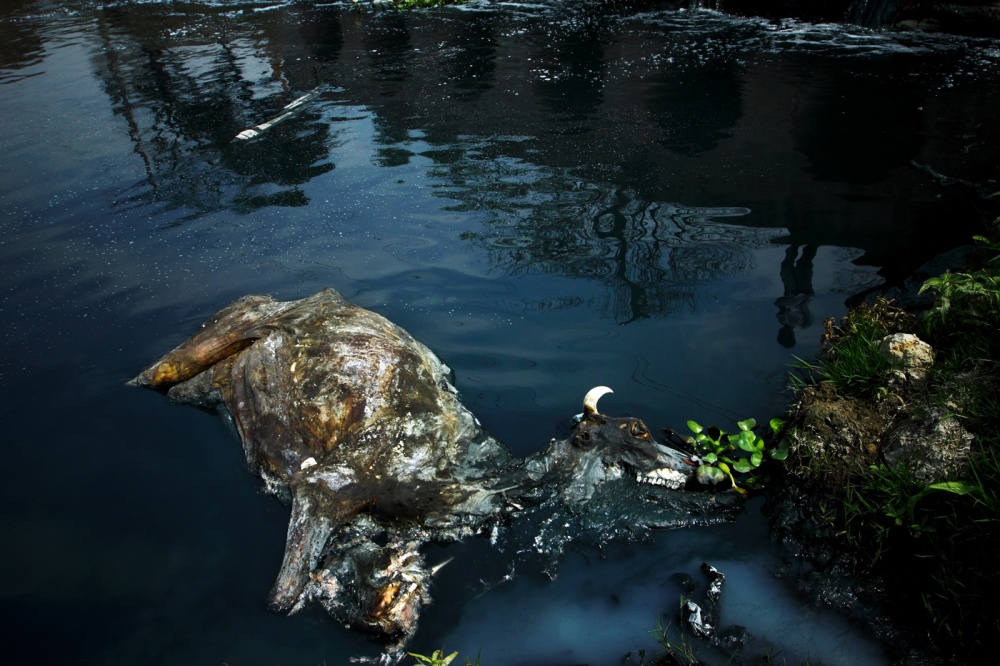
17 of 25
© 2024 Probal Rashid
The growth of industries in Bangladesh has generally been unplanned without keeping the issue of environmental protection in careful consideration. Pollution emitted from the industries is also one of the major factors contributing towards water pollution. Dumping of various industrial waste products into water sources, and improper contamination of industrial wastes, often result in polluting the water. Such water pollution disturbs the balance of the ecosystem inside, resulting in the death of various domestic animal and plant species present in the water.

18 of 25
© 2024 Probal Rashid
The emission of various greenhouse gases such as CO2, methane (CH4), among others from various industries, increases the overall temperature of the earth, resulting in global warming. Dumping of various industrial waste products into water sources, and improper contamination of industrial wastes, often result in polluting the water. Such pollution disturbs the balance of the ecosystem inside, resulting in the death of various animal and plant species.

19 of 25
© 2024 Probal Rashid
A young boy washes his cloth by using the polluted river water. The industrial areas in Bangladesh are situated in the midst of densely populated regions and the growth of industries has generally been unplanned without keeping the issue of environmental protection in careful consideration. Gazipur District is one such industrial cluster where rapid, unplanned industrial expansion has led to serious local pollution. Indiscriminate discharge of liquid waste by the industries has ruined a large part of the Turag River, causing immense suffering to residents living on the banks, fertile agricultural land is becoming infertile, disturbs the balance of the ecosystem inside, resulting in the death of various animal and plant species.

20 of 25
© 2024 Probal Rashid
Resident of riverbank is using the polluted water of Turag River. Indiscriminate discharge of liquid waste by the industries in and around Gazipur industrial zone has ruined a large part of the Turag River and Baimail Jheel, causing immense suffering to residents living on the banks. Moreover, the existence of heavy toxic metals such as chromium in the surrounding areas of Turag River may cause cancerous diseases.

21 of 25
© 2024 Probal Rashid
Every day 9 year old Jashim collects pieces of cloth from liquid waste of dyeing industries and after the selling of findings to traders, earns a scanty sum of money. The acid based chemicals used for processing the hides are released directly into the Turag River. Like many other industries unconcerned about the environmental factors, tanneries also cause serious damage to the environment.

22 of 25
© 2024 Probal Rashid
Young girl washes her cloth using polluted river water. The industrial areas in Bangladesh are situated in the midst of densely populated regions and the growth of industries has generally been unplanned without keeping the issue of environmental protection in careful consideration. Gazipur District is one such industrial cluster where rapid, unplanned industrial expansion has led to serious local pollution. Indiscriminate discharge of liquid waste by the industries has ruined a large part of the Turag River, causing immense suffering to residents living on the banks, fertile agricultural land is becoming infertile, disturbs the balance of the ecosystem inside, resulting in the death of various animal and plant species.

23 of 25
© 2024 Probal Rashid
Indiscriminate discharge of liquid waste by the industries in and around Gazipur industrial zone has ruined a large part of the Turag River and Baimail Jheel, causing immense suffering to residents living on the banks.

24 of 25
© 2024 Probal Rashid
Every day large amount of the industrial wastewater flow to the Turag River from Gazipur Industrial District. The wastewater sometimes is black, gray, silver or yellow, from different chemical factories has different colors.

25 of 25
© 2024 Probal Rashid
Dumping of various industrial waste products into water sources, and improper contamination of industrial wastes, often result in polluting the water. Such water pollution disturbs the balance of the ecosystem inside, resulting in the death of various domestic animal and plant species present in the water.
Public Story
Pollution in Bangladesh
